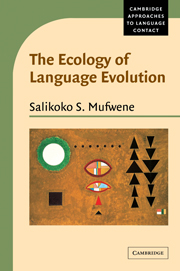Book contents
- Frontmatter
- Contents
- List of illustrations
- Preface
- Acknowledgments
- 1 Introduction
- 2 The Founder Principle in the development of creoles
- 3 The development of American Englishes: factoring contact in and the social bias out
- 4 The legitimate and illegitimate offspring of English
- 5 What research on the development of creoles can contribute to genetic linguistics
- 6 Language contact, evolution, and death: how ecology rolls the dice
- 7 Past and recent population movements in Africa: their impact on its linguistic landscape
- 8 Conclusions: the big picture
- Notes
- References
- Author index
- Subject index
2 - The Founder Principle in the development of creoles
Published online by Cambridge University Press: 18 December 2009
- Frontmatter
- Contents
- List of illustrations
- Preface
- Acknowledgments
- 1 Introduction
- 2 The Founder Principle in the development of creoles
- 3 The development of American Englishes: factoring contact in and the social bias out
- 4 The legitimate and illegitimate offspring of English
- 5 What research on the development of creoles can contribute to genetic linguistics
- 6 Language contact, evolution, and death: how ecology rolls the dice
- 7 Past and recent population movements in Africa: their impact on its linguistic landscape
- 8 Conclusions: the big picture
- Notes
- References
- Author index
- Subject index
Summary
The original title of this chapter was “the Founder Principle in creole genesis.” I have modified it here because, as pointed out in the Preface, the established phrase creole genesis is misleading. Although there has been a great deal of interest in the origins of creoles' structural features, much of the research in genetic creolistics has been on the development of these vernaculars, which was a protracted process. Such scholarship has also focused on their identification as separate varieties, hence on the speciation of their lexifiers into diverse new varieties. The latter interest has justified discussing creoles' “life cycles” too, for instance whether or not they have “decreolized,” i.e., lost their basilectal features and become structurally closer to their acrolects. These concerns all remain in the present chapter, and I find the term development of creoles truer to the subject matter.
This essay is not the first in which I have elaborated my population genetics approach. That distinction goes to “Creole genesis: a population genetics perspective,” presented at the meeting of the Society for Pidgin and Creole Linguistics, at the University of Amsterdam in 1993, but published only a couple of months before this one, in 1996 (cited here as Mufwene 1996b). However, in the present essay, I had an opportunity not only to articulate my hypotheses more explicitly but also to sketch out a long-term research agenda with several questions and issues that I would address in later essays.
- Type
- Chapter
- Information
- The Ecology of Language Evolution , pp. 25 - 80Publisher: Cambridge University PressPrint publication year: 2001
- 1
- Cited by

